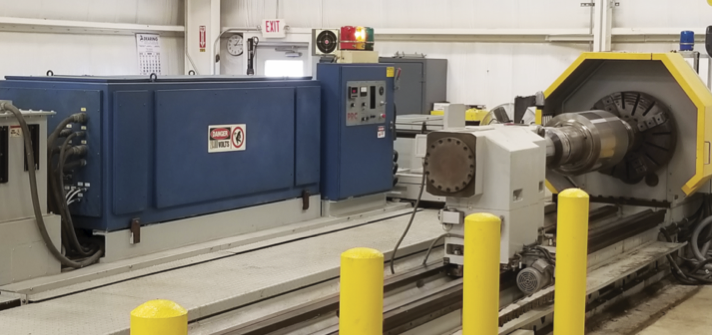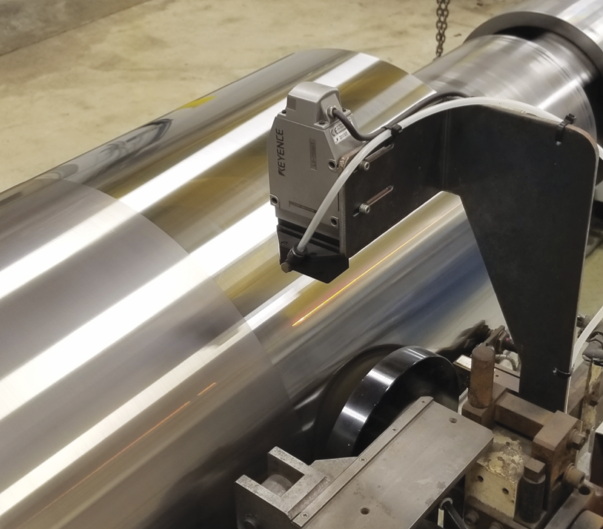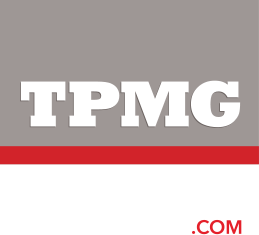Mill brings laser texturing process to North America to improve drawing and forming operations
Above: LaserMatte produces microcraters in the surface of the mill roll that is then used to emboss the uniform matte finish that can’t be reproduced by conventional methods.
Mill brings laser texturing process to North America to improve drawing and forming operations
May 2019 - Benjamin Franklin’s inventions—from the Franklin stove to bifocals—were practical, engineered to make the lives of colonists easier.
Greer Steel Co., based in Dover, Ohio, has also built a reputation for using technology and innovation to help customers solve problems. The 102-year-old cold-rolled strip steel mill is a resource for a wide range of products and services. One in particular—LaserMatte—was designed to improve drawing and forming operations for products that need a matte finish.
The laser texturing process produces microcraters in the surface of mill rolls to create a uniform matte finish. The embossed relief pattern aids the metal’s capacity to carry lubricant consistently across the rolled strip and enhances drawability. Textured or matte finishes also promote bonding and paint adhesion to enhance the cosmetic look of formed components.

The embossed relief pattern delivered by a 2.8 kW CO2 laser machine aids the metal’s capacity to carry lubricant consistently across the strip and enhances drawability.
In North America, cold rolling mills have typically created matte finishes with conventional methods such as shot or grit blasting. Electro-discharge texturing (EDT) has been used for more demanding applications. In Asia and Europe, mills also use a more refined method to produce a matte finish on material. The system employs a laser or electron beam to deliver a non-random pattern—to defined depths and spacing parameters—on the sheet surface.
Lubrication reduces friction, enhances metal flow and prevents localized strains that can lead to metal failure in formed and drawn flat-rolled sheets. Consistent lubrication can also extend tooling life, minimizing the costs associated with changeovers, downtime or damaged material.
Through its own research, Greer Steel recognized the advantages of bringing this uniform metal surface topography to the North American market.
“The technology was originally developed in Japan for use on automotive body panels,” says Todd Daenzer, Greer Steel’s director of technical services. “Deep draw and forming applications have seen the most significant advantages domestically.
“As part of our investigation into the technology, we had discussions with a customer that had performed development work with this type of finish. They shared the positive impact that the technology had on their drawing operations and their interest in having a domestic source for the product,” he says.
A ready customer base led Greer Steel to introduce LaserMatte. So how does it work? A 2.8 kW CO2 laser machine produces a microscopic beam that is interrupted by a timed aluminum chopper wheel that divides the light beam into pulses. The pulses strike the roll’s surface 40,000 times a second in a helical pattern, creating small, equally placed microcraters with non-random pitch and spacing. This matte finish can’t be reproduced by conventional methods.
“Shotblasting and EDT are very random in surface topography, which results in greater variability and inconsistency,” notes Daenzer.
3D images tell the story. The pronounced, sharp peaks of a shotblast finish are prone to abrading tooling surfaces, bending or breaking off, and potentially contaminating the lubricant. This leads to inconsistent draws, elevated press loads and accelerated tooling wear.
The LaserMatte surface minimizes point loading, provides a negatively skewed surface and reduces the potential for galling, fracture and part distortion. Surface skewness compares the relationship of peaks and valleys. A positive skew means there are more peaks than valleys. A negative skew reveals a higher volume of valleys, which allows for greater retention of die lubrication in the forming and drawing processes.

Pulses strike the roll’s surface 40,000 times a second in a helical pattern, creating small, equally placed microcraters with non-random pitch and spacing.
Despite LaserMatte’s advantages, Daenzer finds educating the industry about the process a bit like “swimming upstream. The industry is largely familiar with a shotblasted finish, and some are familiar with EDT. LaserMatte is still a fairly new option in terms of awareness.”
Greer Steel offers LaserMatte in widths up to 261⁄2-in., in both standard and custom tailored RA ranges on grades 1001 to 1095; high-strength low-alloy at 35 to 150 ksi; and alloy grades ranging in hardnesses from dead soft to full hard.
“Being a fully capable cold mill, customers aren’t stuck with standard gauges, strengths and widths,” Daenzer explains. “Greer Steel will tailor products to specific requirements. And while the LaserMatte finish is offered on fully processed cold-rolled steel, it can be applied to other products, such as copper, brass and aluminum, on a customer-supplied conversion basis.”
The matte finish process is suited to a diverse number of applications and markets ranging from small appliances and hand tools to automotive and agriculture parts. Deep drawn stampings such as bearing or air bag components are suitable candidates for the LaserMatte process.
Greer Steel has seen an uptick in demand for the matte finish in applications that require friction material to bond to steel surfaces. “Brake, clutch and automatic transmission components all require consistent adhesion for superior performance,” says Daenzer.
But LaserMatte is more than just a “pretty face,” he says. “It is a functional enhancement.” Customers who use the matte finish products report a number of benefits that include higher process yield, improved component dimension stability and improved material flow without the need for costly material or tool and die coatings.
As a surface conditioning method, LaserMatte is proving itself on customers’ shop floors, helping them to solve problems that routinely hamper production and drain resources. The busy inventor Ben Franklin might be pleased. FFJ












